Editor’s Note: This is the second story in a two-part collaboration between Oregon Public Broadcasting and KUNC, Community Radio for Northern Colorado. The first part is available here.
If any of the wolves released on Colorado’s Western Slope ever make it to the sprawling hills near the Stanko ranch in northwest Colorado, the family hopes the predators won’t want to go near Samson.
The 11-week-old Turkish Boz Shepherd didn’t look menacing on a cold day last month when he playfully pawed at a bone his sibling was chewing near the livestock pens. But each week, Samson is putting on pounds, developing a deeper bark and bonding with the dozens of pigs, cows and hens he’s being raised to protect from the new wolf packs.
He’s also spending more time just staring out into the hills surrounding this ranch, which is home to more than a hundred bird species and a cattle operation the Stanko family has run for more than a century.
Even Samson’s ears were cropped to prevent a predator like a wolf from grabbing onto him during a skirmish.
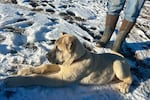
Samson, an 11-week-old Turkish Boz Shepherd, watches one of his siblings chew on a bone at the Stanko ranch in Routt County, Colo. Samson is the newest guard dog on the ranch and is being raised specifically to deter wolves from attacking livestock.
Scott Franz / KUNC
“He’s pretty fearless, which is kind of a surprise for a puppy,” Jan Stanko said of the dog she’s been training for guard duty. “That could be a good thing, or a bad thing.”
Like hundreds of other ranchers in Colorado, the Stanko family is anxious about wolf packs being airlifted back to this state, where they were eradicated by the 1940s.
The Stankos’ 2,000-acre cattle ranch is in Routt County. Upscale restaurants in nearby Steamboat Springs serve locally-raised beef, and 60% of the county’s voters opposed the 2020 ballot question to reintroduce wolves.
Three years and dozens of contentious public hearings later, the first five wolves from Oregon were released Monday in neighboring Grand County.
“Just watching the animal leave the crate and run up the hillside, I think anybody that was there that had a chance to see it, it’s a pretty majestic thing,” Colorado Parks and Wildlife Species Conservation Manager Eric Odell told KUNC hours after the release. “It’s a pretty, pretty awesome thing to see.”
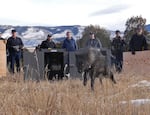
Colorado Parks and Wildlife released five gray wolves onto public land in Grand County, Colo., on Monday. Pictured is wolf 2302-OR.
Courtesy of Colorado Parks and Wildlife
Some ranchers have been fighting the upcoming wolf releases at the statehouse, and as recently as last week, in a federal courtroom. Jo Stanko, Jan’s mother in law, said the family took a different path.
She said they quickly accepted the outcome and started preparing for it, even before voters cast the final votes to approve the reintroduction of wolves in 2020. That’s why four years ago, they went dog shopping. Now they have three big dogs raised specifically to deter wolves.
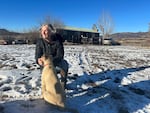
Jan Stanko poses with Samson, a livestock guardian dog she is training to protect the cows, pigs and sheep that live on the Stanko ranch in northwest Colorado.,
Scott Franz / KUNC
“If there’s enough of you dogs, the wolves will be like, let’s just skip this property,” Jan Stanko said as she gave Samson a pep talk last month. “You guys will protect the sheep and the birds and the calves and the pigs.”
Jo Stanko said having any cattle attacked by wolves would feel like losing the lottery. She thinks often of the worst case scenario: finding one of their animals still alive, but suffering, after a wolf attack.
“That’s emotional, because not being able to support your family and not being able to take care of your livestock kind of gives you a feeling of being unsuccessful, and that’s hard,” she said.

Pat Stanko uses a tractor to feed his cattle in northwest Colorado. The Stankos say they've seen wolves near their property years ago, but they avoided attacking livestock.
Scott Franz / KUNC
But Jo Stanko said they’re also approaching the situation with some levity.
“You can either laugh or cry,” she said. “Sometimes we wonder, jokingly: Will Maverick, our biggest guard dog, even recognize a wolf? How is he going to know it’s a wolf and, you know, not a coyote or those kinds of things?”
Just another predator
To the south of the Stanko ranch, people living within the designated wolf drop zones have other concerns.
Lisa Langer, the tourism director in Glenwood Springs, said people living in her resort town are more leery of wolves than excited about their arrival.
“This is just another predator now, so another thing to watch out for with children and small animals,” she said. “We just have to be cautious.”
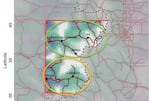
The area circled in green is the top location Colorado Parks and Wildlife is eying as a wolf release site this winter. The area in yellow is an alternative site for future years.
Map courtesy of Colorado Parks and Wildlife
A Colorado State University survey done prior to the approval of Colorado’s wolf reintroduction plan showed a significant number of state residents believed the addition of wolves would “enhance tourism opportunities” in the state. Shops in Glenwood Springs and other tourist towns regularly sell shirts and apparel adorned with bears, moose and other wildlife. Could wolves become a new form of marketing for the town?
Langer isn’t convinced.
“No, I don’t think the wolf introduction will be a boon to tourism,” Langer said. “I think that it may be a detriment in some ways.”
Langer worries that because wolves are predators, they might even scare away some visitors from the hiking trails near Glenwood Springs, just as mountain lions do. And while other areas, including Yellowstone National Park, have developed a dedicated group of wolf watchers, Langer said it will be different in Colorado.
“Those situations in a national park are isolated to a national park,” Langer said. “We’re talking about communities in Colorado with a lot of public lands surrounding us. However, we don’t know where those wolf packs are going to be.”
The state’s tourism office also doesn’t appear to be howling with enthusiasm for the arrival of the wolves, either. Officials declined an interview request from KUNC to talk about what impact they see wolves having on tourism.
Tears of joy
On the other side of Colorado’s continental divide, Rob Edward isn’t anxious at all about the incoming wolves. The director of the Rocky Mountain Wolf Project is overcome with emotion as he talks about how excited he is to witness a reintroduction he’s been pursuing for more than a quarter century.
Edward sees wolves as a vital part of Colorado’s landscape. And he predicts that in the coming decades, their return will have a ripple effect. He said elk and deer will become more mobile as they avoid the predator. That means more willow and aspen trees will grow, bringing more songbirds. Even the rivers, he said, will benefit from this chain of events.

Rob Edward takes a break with his Australian Cattle Dog, Bella Blue, near the top of Old Fall River Road in Rocky Mountain National Park.
Photo courtesy of Anne Edward
“It’s a manifestation of my life’s work, and I feel extremely fortunate to have spent my life doing something that culminates in the world being a better place from an ecological perspective,” he said.
Edward is planning to go on a wolf watching trip once he finds out where the wolves are. He predicts the wolves won’t be making a beeline for city centers after they take their first steps from their cages.
“These big dogs are going to be pretty freaked out,” he said. “So they’re going to try to get away from all the hubbub as quickly as possible. Hopefully they’ll keep tabs on each other and travel together, and ultimately mate. And maybe even by this spring we can have pups on the ground in central Colorado. That’s huge.”
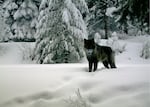
FILE: Photo of a young wolf from Oregon's Walla Walla Pack taken on Feb 5, 2014. Oregon is donating up to 10 wolves to Colorado for reintroduction on the Western Slope.
Photo courtesy of the Oregon Department of Fish and Wildlife
Adrian Treves, an environmental studies professor at the University of Wisconsin-Madison, also said he thinks wolves are poised to improve Colorado’s landscape. Treves points to studies showing the presence of wolves makes forests more resilient to invasive plants and even reduces vehicle collisions with deer and moose by making the prey more alert and unlikely to enter populated areas.
“We hear a lot about farm animals being lost, and, ‘Ohhh, this is such a terrible cost.’ But it’s less than 1% of farms everywhere it’s been studied, or less than 1% of the standing livestock, that are ever affected by wolves,” Treves said. “So those costs are completely dwarfed by these economic and ecosystem benefits that wolves are generating.”
Fighting to the end
As recently as Dec. 15, it wasn’t clear if Colorado would be allowed to move ahead with plans to start releasing wolves from Oregon this week. The Colorado Cattlemen’s Association and the Gunnison County Livestock Growers Association sued Colorado Parks and Wildlife and the federal government to pause the process.
The ranching groups have opposed the reintroduction since it was approved by voters, saying wolves will kill livestock and create stress for ranchers as they spend more of their time guarding against the predators. The lawsuit alleged state wildlife officials should have to do an environmental impact study before proceeding with the wolf release.
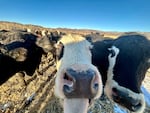
The cows on the Stanko ranch in northwest Colorado are fed cookies as treats. When they don't get any, they resort to trying to lick humans.
Scott Franz / KUNC
“I think the economic impact to rural communities are not adequately addressed, or even addressed at all,” said the Colorado Cattlemen’s Association vice president Erin Karney. “When people in rural communities are attacked and not heard by the government, I think this is our way of saying, ‘Hey, we are citizens of Colorado, and we deserve to be heard.’”
The state has taken several steps to prevent or lessen the financial blow of wolves attacking livestock. Lawmakers created a new “Born to Be Wild” license plate adorned with a wolf to raise hundreds of thousands of dollars per year for equipment and programs designed to prevent wolves from attacking livestock.
Colorado has also created a compensation program that will pay ranchers up to $15,000 for each animal killed by a wolf, including livestock and working dogs. This is double the amount the state originally proposed to spend and is designed to cover the “fair market value” of an animal.
The state also held dozens of public hearings and convened a working group of biologists, ranchers, hunters, outfitters and conservationists to create a wolf management plan.

FILE: A subadult Wenaha wolf stretches in the snow in front of a remote camera in Oregon's Wenaha Wildlife Management Unit on April 13, 2013. Oregon residents and ranchers have mixed feelings about the state donating wolves to Colorado.
Photo courtesy of the Oregon Department of Fish and Wildlife / Photo courtesy of the Oregon Department of Fish and Wildlife
A federal judge on Friday denied the ranching groups’ request to pause the reintroduction. The judge said pausing the reintroduction would not be in the public interest because voters mandated it through a ballot measure, according to reporting from the Associated Press.
Making allies
Back on the Stanko Ranch in Routt County, Jo Stanko was ready for this week’s release.
“Let’s get it over with,” she said recently as uncertainty swirled amid the federal lawsuit around reintroduction. “Let’s recognize how hard everybody worked and let’s get it over with.”
She praised Colorado Parks and Wildlife for how the agency has managed the reintroduction. And she said the sooner wolves arrive, the sooner there can be a sense of normalcy surrounding life with wolves in the state.

Jo Stanko checks on a cow on her ranch in Routt County, Colo., during a feeding session Nov. 28, 2023. Stanko said her ranch runs on tight financial margins, and if a cow is lost to a wolf attack, it can't easily be replaced by money.
Scott Franz / KUNC
Jo Stanko isn’t your average rancher, though. Not only does Stanko have a bigger dog pack keeping an eye on the hills around the ranch, she’s also spent time building relationships with wolf advocacy groups. Last year, she invited three dozen wolf advocates and livestock producers to her ranch so both sides could learn more about each other’s feelings about the reintroduction process. If wolves do cause problems in the coming weeks, she has wolf biologists on speed dial she can call to find solutions.
“We’re both highly involved in environmental issues, and we want what’s best for the environment,” she said of ranchers and wolf reintroduction advocates. “We just have had a disagreement on how to do it.”